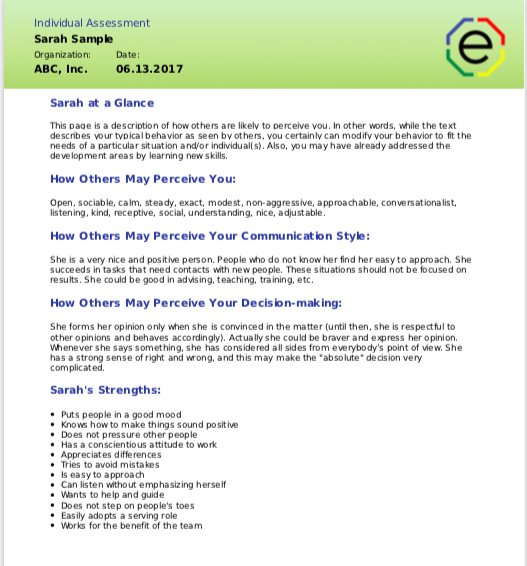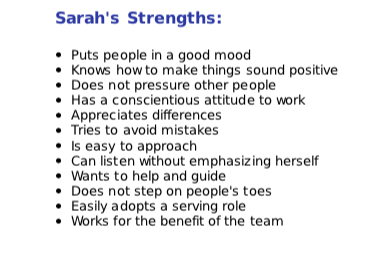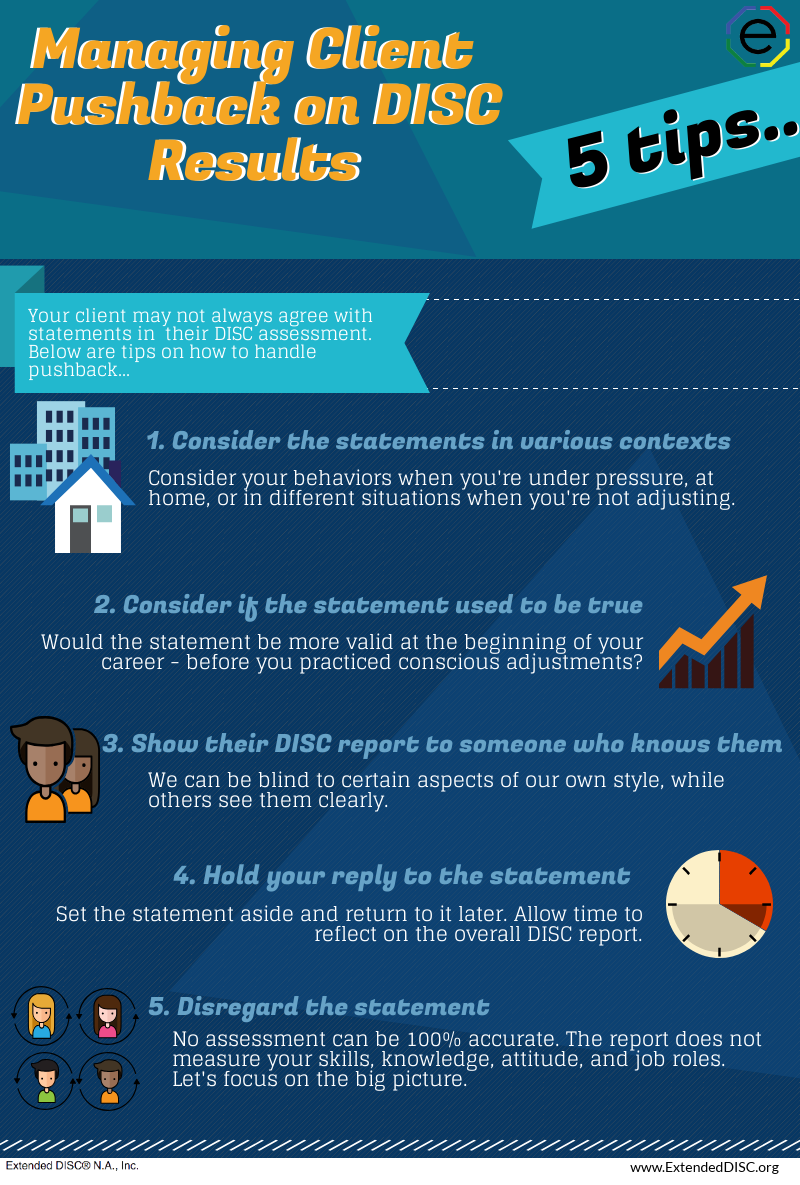The Extended DISC® Assessment’s ‘At a Glance’ section provides a brief visual overview of your client’s behavioral style and much more.
The Extended DISC® Assessment’s ‘At a Glance’ section provides a narrative description of your client’s typical behaviors as seen by others. Think of it as an introduction to their behavioral style by visually describing their most typical and natural behaviors. Ask your client to read the text as such and use it to develop an overall picture since the results are unique to them. It provides additional information to help in understanding their behaviors and how they tend to show up.
This section helps to qualify the validity of their Profile and Diamond results and creates a visual representation of your client’s natural style by providing additional information to help in understanding their behaviors. We suggest, as a coach, you review and analyze their Profile and Diamond results first and then use this section to initiate dialogue by helping them better understand how they tend to come across to others.
Your client at a glance
 When reading their ‘At a Glance’ section, have your clients consider their conscious ability to adapt their behaviors to fit the needs of a specific situation. The description doesn’t account for what they’ve learned outside of their natural style. They may have already addressed the development area by learning and practicing it. An example would be if they are a high I-style and they learned to be much more organized and detailed-oriented than their natural style would’ve predicted.
When reading their ‘At a Glance’ section, have your clients consider their conscious ability to adapt their behaviors to fit the needs of a specific situation. The description doesn’t account for what they’ve learned outside of their natural style. They may have already addressed the development area by learning and practicing it. An example would be if they are a high I-style and they learned to be much more organized and detailed-oriented than their natural style would’ve predicted.
It does not recognize who your client believes they need to be, since this section focuses on their most natural and spontaneous behaviors. For example, they may have seen themselves as very decisive in the environment they grew up in, but when compared to all people, they would not be considered that decisive.
Interpretation tips for you and your client
 The ‘At a Glance’ section is further broken down into subsections. In the standard Individual Assessment, the section often starts with, How Others May Perceive You; which describes your client’s natural attributes. Ask them to consider the descriptors and highlight the ones most significant to their effectiveness in their current role.
The ‘At a Glance’ section is further broken down into subsections. In the standard Individual Assessment, the section often starts with, How Others May Perceive You; which describes your client’s natural attributes. Ask them to consider the descriptors and highlight the ones most significant to their effectiveness in their current role.
The How Others May Perceive Your Communication Style describes how someone, based on their natural style (Profile II) prefers to communicate. You can help your clients identify the statements they believe contribute to their ability to communicate effectively. Additionally, are there descriptions that may cause them to be less effective and why?
The How Others May Perceive Your Decision-making describes how someone with your natural style (Profile II) prefers to make decisions. Ask your client to consider how their decision-making style contributes to their success and how it may cause them to be less successful.
Focusing in on Strengths
 Your client’s Strengths identifies some of their key strengths. Help your client consider, in their current position, how well are they taking advantage of their greatest strengths. They are unlikely to disagree with this section since it tends to be complementary, but strengths are more than what your client may be good at. Are there times they have overused their strengths to a point they became a weakness and a serious liability to their performance? What can they do differently in the future to avoid the overuse of their strengths?
Your client’s Strengths identifies some of their key strengths. Help your client consider, in their current position, how well are they taking advantage of their greatest strengths. They are unlikely to disagree with this section since it tends to be complementary, but strengths are more than what your client may be good at. Are there times they have overused their strengths to a point they became a weakness and a serious liability to their performance? What can they do differently in the future to avoid the overuse of their strengths?
 Consider the ‘too’ effect. Have your clients review the How Others May Perceive You to select 2 – 3 attributes or identify statements in the Strengths they feel describe themselves the most. Then have them focus on each of the attributes or statements and think of times where they have overused the attribute or strength.
Consider the ‘too’ effect. Have your clients review the How Others May Perceive You to select 2 – 3 attributes or identify statements in the Strengths they feel describe themselves the most. Then have them focus on each of the attributes or statements and think of times where they have overused the attribute or strength.
In fact, ask them to put the word ‘too’ in front of the descriptor or statement. For example, if you identified one of your attributes as ‘independent,’ were there situations where you were ‘too independent’ that it got you into trouble? Remember, strengths are natural and most comfortable to our DISC style. They don’t take additional energy or thought so we can get into trouble by overusing them.
Additional coaching strategies and tips
As your client is going through this section, ask them to put a check mark next to comments they agree with. In addition, ask them to place a question mark next to comments they’re not sure about or disagree with. In fact, it’s a great idea to use check marks and question marks as they review their entire report. The Extended DISC® Assessment is designed to identify blind spots that may be holding back your client’s performance.
 You can expect there to be some attributes or statements your client disagrees with. If they disagree with a word or a statement, ask them to consider the statement in different situations or allow them time for reflection. You can ask them if the statement was true at one point in time, but they’ve consciously worked on these development areas. They can get feedback on the statements they’ve marked with question marks from someone who knows them well. Ultimately, remind them to reflect on the entire report and focus on the big picture.
You can expect there to be some attributes or statements your client disagrees with. If they disagree with a word or a statement, ask them to consider the statement in different situations or allow them time for reflection. You can ask them if the statement was true at one point in time, but they’ve consciously worked on these development areas. They can get feedback on the statements they’ve marked with question marks from someone who knows them well. Ultimately, remind them to reflect on the entire report and focus on the big picture.
As with all Extended DISC Assessments, you can further customize the content including this section. You can add additional content such as identifying the person’s ideal supervisor, motivators, and situations that reduce motivation.
Contact us to learn more! CustomerService@ExtendedDISC.org
